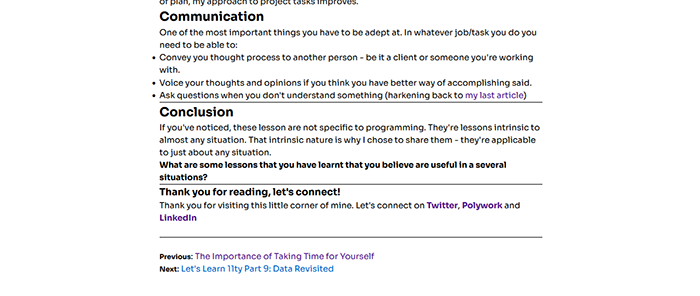
James 'Dante' Midzi
Posted on August 4, 2022

In our last article we used external data to render posts on our site.
If you noticed, we don't have that cool Previous/Next Post that was at the bottom of our posts before.
Wouldn't it be nice to have that back? That is the main focus of this article.
Let's first look at what our post pagination looked like before with local posts
{% set previousPost = collections.post | getPreviousCollectionItem(page) %}
{% set nextPost = collections.post | getNextCollectionItem(page) %}
{% if previousPost %}Previous: <a href="{{ previousPost.url }}">{{ previousPost.data.title }}</a>{% endif %}
<br>
{% if nextPost %}Next: <a href="{{ nextPost.url }}">{{ nextPost.data.title }}</a>{% endif %}
Above, we were making use of what I called one of the cornerstones of Eleventy - collections.
This method will not work for the posts we've fetched from Hashnode because they aren't part of a collection like the posts we had.
To bring that functionality back we will need to add a couple things to our .eleventy.js
A Collection
When we started this series we made a collection - for our pages. We are going to employ that same knowledge to make a collection from our Hashnode posts.
In .eleventy.js add this:
eleventyConfig.addCollection("articles", async () => {
const endpoint = `https://api.hashnode.com/`;
const { GraphQLClient, gql } = require("graphql-request");
const client = new GraphQLClient(endpoint);
const query = gql`
{
user(username: "Psypher1") {
publication {
posts {
title
coverImage
brief
slug
dateAdded
contentMarkdown
}
}
}
}
`;
const articles = await client.request(query);
return articles.user.publication.posts;
});
We have used the same piece of code that we had in our posts.js file, but this time to create a collection.
A Filter
In our original code we also had this filter: getPreviousCollectionItem(page) - this is what gets us the next and previous functionality.
For that, we will also make a filter in the same .eleventy.js file
elevntyConfig.addFilter("nextArticle", (articles, page, modifier = 1) => {
const parts = page.outputPath.split("/");
parts.pop(); // get rid of `index.html`
const slug = parts.pop();
for (const [index, article] of articles.entries()) {
const target = index + modifier;
if (article.slug === slug && target >= 0 && target < articles.length) {
return articles[target];
}
}
});
What we have done now works beacuse:
The data (articles) returned in the collection sort of guides how next/previous are going to work
Paginate Partial
Then we will change/create our _paginate.njk file to look like this:
{% set previousPost = collections.articles | nextArticle(page) %}
{% set nextPost = collections.articles | nextArticle(page, -1) %}
{% if previousPost %}Previous: <a href="/blog/{{ previousPost.slug }}">{{ previousPost.title }}</a>{% endif %}
<br>
{% if nextPost %}Next: <a href="/blog/{{ nextPost.slug }}">{{ nextPost.title }}</a>{% endif %}
Then we come into our postLayout.njk file and include it at the bottom
{% include "partials/_paginate.njk" %}
And there we go. We are back where we were.
Special thanks goes to Shiv Jha-Mathur from the Eleventy Discord who provided the guidance and solution to this particular conundrum.
My Quest For You
Now that we've seen how we can fetch articles from an API and still have the same functionality we had with local ones. Try to see how you can combine everyhing we've learnt in the series into one complete site.
In the meantime, I will work on updating the series repo - do the different branches per part thing.
Wish me luck 😄
Thank you for reading, let's connect!
Thank you for visiting this little corner of mine. Let's connect on Twitter, Polywork and LinkedIn

Posted on August 4, 2022
Join Our Newsletter. No Spam, Only the good stuff.
Sign up to receive the latest update from our blog.
